
A | B | C | D | E | F | G | H | CH | I | J | K | L | M | N | O | P | Q | R | S | T | U | V | W | X | Y | Z | 0 | 1 | 2 | 3 | 4 | 5 | 6 | 7 | 8 | 9


Seal hunting, or sealing, is the personal or commercial hunting of seals. Seal hunting is currently practiced in nine countries: United States (above the Arctic Circle in Alaska), Canada, Namibia, Denmark (in self-governing Greenland only), Iceland, Norway, Russia, Finland and Sweden. Most of the world's seal hunting takes place in Canada and Greenland.
The Canadian Department of Fisheries and Oceans (DFO) regulates the seal hunt in Canada. It sets quotas (total allowable catch – TAC), monitors the hunt, studies the seal population, works with the Canadian Sealers' Association to train sealers on new regulations, and promotes sealing through its website and spokespeople. The DFO set harvest quotas of over 90,000 seals in 2007; 275,000 in 2008; 280,000 in 2009; and 330,000 in 2010.[1] The actual kills in recent years have been less than the quotas: 82,800 in 2007; 217,800 in 2008; 72,400 in 2009; and 67,000 in 2010.[2] In 2007, Norway reported that 29,000 harp seals were killed, Russia reported that 5,479 seals were killed and Greenland reported that 90,000 seals were killed in their respective seal hunts.
Harp seal populations in the northwest Atlantic declined to approximately 2 million in the late 1960s as a result of Canada's annual kill rates, which averaged to over 291,000 from 1952 to 1970.[3] Conservationists demanded reduced rates of killing and stronger regulations to avert the extinction of the harp seal. In 1971, the Canadian government responded by instituting a quota system. The system was competitive, with each boat catching as many seals as it could before the hunt closed, which the Department of Fisheries and Oceans did when they knew that year's quota had been reached. Because it was thought that the competitive element might cause sealers to cut corners, new regulations were introduced that limited the catch to 400 seals per day, and 2000 per boat total. A 2007 population survey conducted by the DFO estimated the population at 5.5 million. [citation needed]
In Greenland, hunting is done with a firearm (rifle or shotgun) and young are fully protected.[4] This has caused some conflicts with other seal-hunting nations, as Greenland also was hit by the boycotts that often were aimed at seals (often young) killed by clubbing or similar methods, which have not been in use in Greenland.[5] It is illegal in Canada to hunt newborn harp seals (whitecoats) and young hooded seals (bluebacks). When the seal pups begin to molt their downy white fur at the age of 12–14 days, they are called "ragged-jacket" and can be commercially hunted.[6] After molting, the seals are called "beaters", named for the way they beat the water with their flippers.[7] The hunt remains highly controversial, attracting significant media coverage and protests each year.[8] Images from past hunts have become iconic symbols for conservation, animal welfare, and animal rights advocates. In 2009, Russia banned the hunting of harp seals less than one year old.
Terminology
The term seal is used to refer to a diverse group of animals. In science, they are grouped together in the Pinnipeds, which also includes the walrus, not popularly thought of as a seal, and not considered here. The two main families of seals are the Otariidae (the eared seals; includes sea lions, and fur seals), and Phocidae (the earless seals); animals in the family Phocidae were sometimes referred to as hair seals, and are much more adept for a fully aquatic lifestyle than the eared seals, though they have a more difficult time getting around on land.
Uses
The fur seal yields a valuable fur; the hair seal has no fur, but oil can be obtained from its fat and leather from its hide.[9] Seals have been used for their pelts, their flesh, and their fat, which was often used as lamp fuel, lubricants, cooking oil, a constituent of soap, the liquid base for red ochre paint, and for processing materials such as leather and jute. Pinseal was fashioned into handbags, and seal livers were an early source of insulin. Early commercial sealers discarded most of the flesh, but might save seal hearts and flippers for an evening meal.[10]
History
Traditional seal hunting

Archeological evidence indicates the Native Americans and First Nations People in Canada have been hunting seals for at least 4,000 years. Traditionally, when an Inuit boy killed his first seal or caribou, a feast was held. The meat was an important source of fat, protein, vitamin A, vitamin B12 and iron,[11] and the pelts were prized for their warmth. The Inuit diet is rich in fish, whale, and seal.
There were approximately 150,000 circumpolar Inuit in 2005 in Greenland, Alaska, Russia, and Canada.[12] According to Kirt Ejesiak, former secretary and chief of staff to then-Premier of Nunavut, Paul Okalik and the first Inuk from Nunavut to attend Harvard, for the c. 46,000 Canadian Inuit, the seal was not "just a source of cash through fur sales, but the keystone of their culture." Although Inuit harvest and hunt many species that inhabit the desert tundra and ice platforms, the seal is their mainstay. The Inuktitut vocabulary designates specific objects made from seal bone, sinew, fat and fur used as tools, games, thread, cords, fuel, clothing, boats, and tents. There are also words referring to seasons, topography, place names, legends, and kinship relationships based on the seal. One region of Canada's north is inhabited by the Netsilingmiut, or "people of the seal."[12][13] The title of Ejesiak's article acknowledged the pivotal 1991 publication entitled Animal Rights, Human Rights by George Wenzel, a McGill University geographer and anthropologist who worked more than two decades with the Clyde Inuit of Baffin Island. Wenzel's "scholarly examination" of "the impact of the animal rights movement upon the culture and economy of the Canadian Inuit" was among the first to reveal how animal rights groups, "well-meaning people in the dominant society through misunderstanding and ignorance can inflict destruction" on a vulnerable minority.[14]
Inuit seal hunting accounts for the majority of the seal hunt, but just three percent of the hunt in southern Canada; it is excluded from the European Commission's call in 2006 for a ban on the import, export and sale of all harp and hooded seal products.[15] Ringed seals were once the main staple for food, and have been used for clothing, boots, fuel for lamps, as delicacy, containers, igloo windows, and in harnesses for huskies. Though no longer used to this extent, ringed seals are still an important food and clothing source for the people of Nunavut.[16] Called nayiq by the Central Alaskan Yup'ik people, the ringed seal is also hunted and eaten in Alaska.
Various seal species were also hunted in northwest Europe and the Baltic Sea at least 8,000 years ago.[17][18]
Early modern era

The first commercial hunting of seals by Europeans, is said to have occurred in 1515, when a cargo of fur seal skins from Uruguay was sent to Spain for sale in the markets of Seville.[19]
Newfoundland
Newfoundland and Labrador and the Gulf of St. Lawrence were the first regions to experience large scale sealing. Migratory fishermen began the hunting from as early as the 1500s. Large-scale commercial seal hunting became an annual event starting in 1723 and expanded rapidly near the turn of the 18th century. Initially, the method used was to ensnare the migrating seals in nets anchored to shore installations, known as the 'landsman seal fishery'. The hunt was mainly for the procurement of seal meat as a form of sustenance for the settlements in the area, rather than for commercial gain.[20]
From the early 18th century English hunters began to range further afield – 1723 marked the first time that hunters armed with firearms ventured forth in boats to increase their haul. This soon became a sophisticated commercial operation; the seals were transported back to England, where the seal's meat, fur, and oil were sold separately. From 1749, the import of seal oil to England was being recorded annually, and was used as lighting oil, for cooking, in the manufacture of soap and for the treating of leather.[20]
South Atlantic
It was in the South Seas that sealing became a major enterprise from the late 18th century. Samuel Enderby, along with Alexander Champion and John St Barbe organized the first commercial expedition to the South Atlantic Ocean in 1776, initially with the primary aim of whaling, although sealing began to play a prominent part in the operation as well. More expeditions were sent in 1777 and 1778 before political and economic troubles hampered the trade for some time.[21]
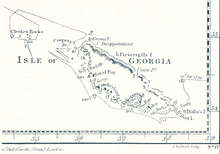
On 1 September 1788, the 270-ton ship Emilia, owned by Samuel Enderby & Sons and commanded by Captain James Shields, departed London. The ship went west around Cape Horn into the Pacific Ocean to become the first ship of any nation to conduct operations in the Southern Ocean. Emilia returned to London on 12 March 1790 with a cargo of 139 tons of sperm oil.[22]
By 1784, the British had fifteen ships in the southern fishery, all from London. By 1790 this port alone had sixty vessels employed in the trade. Between 1793 and 1799 there was an average of sixty vessels in the trade. The average increased to seventy-two in the years between 1800 and 1809.[23][24]
The sealing industry extended further south to the South Georgia island, first mapped by Captain James Cook in HMS Resolution on 17 January 1775. During the late 18th century and throughout the 19th century, South Georgia was inhabited by English and Yankee sealers, who used to live there for considerable periods of time and sometimes overwintered. In 1778, English sealers brought back from the Island of South Georgia and the Magellan Strait area as many as 40,000 seal skins and 2,800 tons of elephant seal oil. More fur seals from the island were taken in 1786 by the English sealing vessel Lord Hawkesbury, and by 1791, 102 vessels, manned by 3,000 sealers, were hunting seals south of the equator. The first commercial visit to the South Sandwich Islands was made in 1816 by another English ship, the Ann.
The sealers pursued their trade in a most unsustainable manner, promptly reducing the fur seal population to near extermination. As a result, sealing activities on South Georgia had three marked peaks in 1786–1802, 1814–23, and 1869–1913 respectively, decreasing in between and gradually shifting to elephant seals taken for oil. Following the discovery of the South Shetland Islands in 1819, the sealing grounds were expanded to what is now the Antarctic Treaty area.[25]
Pacific
Commercial sealing in the Australasian region appears to have started with the London-based Massachusetts-born Eber Bunker, master of the William and Ann, who in November 1791 announced his intention to visit and hunt in New Zealand's Dusky Sound.[26]: 10–11 Captain William Raven of the Britannia stationed a party at Dusky from 1792 to 1793, but the discovery in 1798-1799 of Bass Strait, between mainland Australia and Van Diemen's Land (present-day Tasmania) saw the sealers' focus shift there in 1798, when a gang including Daniel Cooper landed from the Nautilus on Cape Barren Island.[27]
With Bass Strait over-exploited by 1802, commercial attention returned to southern New Zealand waters, where Stewart Island/Rakiura and Foveaux Strait were explored, exploited and charted from 1803 to 1804.[28] Thereafter, the sealing-industry focus shifted to the sub-Antarctic Antipodes Islands, 1805–1807, the Auckland Islands from 1806, the southeast coast of New Zealand's South Island, Otago Harbour and Solander Island by 1809, before focusing further to the south at the newly-discovered Campbell Island (discovered in January 1810) and Macquarie Island (discovered in July 1810) from 1810.[29][30][31] During this period sealers were active on the southern coast of mainland Australia, for example at Kangaroo Island.[32] This whole development has been called[by whom?] the first sealing boom; it sparked the Sealers' War (1810–1821) in southern New Zealand.
Australasian sealing measured its output in terms of skins.[33]
By about 1815, sealing in the Pacific had faded in importance. A brief revival occurred from 1823, but this proved very short-lived.[27] Although highly profitable at times and affording New South Wales one of its earliest trade staples, sealing's unregulated character saw its self-destruction. Notable traders from Britain and based in Australia included Simeon Lord, Henry Kable, James Underwood and Robert Campbell. Plummers of London and the Whitneys of New York also became involved.[26][34][35][36]
By 1830, most Pacific seal-stocks had been seriously depleted, and Lloyd's Register of Shipping only showed one full-time sealing vessel on its books.[19] In the North Pacific, the later 1800s saw large harvests of fur seals. These harvests decreased along with fur-seal populations.
Industrial era

Growing from the international Grand Banks fishery, the Newfoundland hunt initially used small schooners. Kill rates averaged 451,000 in the 1830s, and rose to 546,000 annually during the first half of the next decade, which led to a marked decline in the harp seal population that in turn adversely impacted profits in the sealing industry.[37]
Four hundred schooners carried 13,000 Newfoundland sealers on the annual hunts of the 1850s. An annual kill of 700,000 was estimated[10] when sealing reached its peak in Newfoundland in the 1860s, with the introduction of more powerful and reliable steamships that were capable of much larger range and storing capacity.[38][39] Annual catches exceeded the 400,000 mark from the 1870s and smaller sealers were steadily pushed out of the market.
The first modern sealing ship was the SS Bear, built in Dundee, Scotland in 1874 as a steamer for sealing.[40] The ship was custom-built for sealing out of St. John's, Newfoundland, and was the most outstanding sealing vessel of her day and the lead ship in a new generation of sealers.[41] Heavy-built with 15-centimetre-thick (6-inch) wooden planks, Bear was rigged as a sailing barquentine but her main power was a steam engine designed to smash deep into ice packs to reach seal herds.

At the time of her arrival in St. John's, there were 300 vessels outfitted each season to hunt seals, but most were small schooners or old sailing barques.[42] The new sealing ships represented by Bear radically transformed the Eastern North Atlantic seal fishery as they replaced the hundreds of smaller sealing vessels owned by merchants in outports around Newfoundland with large and expensive steamships owned by large British and Newfoundland companies based in St. John's.[43] Owned at first by the Scottish firm W. Grieve and Sons, she was acquired in 1880 by R. Steele Junior.[44]
Another famous sealing ship of the era was the Terra Nova, originally built in 1884 for the Dundee whaling and sealing fleet. She was ideally suited to the polar regions and worked for 10 years in the annual seal fishery in the Labrador Sea. Large and expensive ships required major capital investments from British and Newfoundland firms, and shifted the industry from merchants in small outports to companies based in St. John's, Newfoundland. By the late 19th century, the sealing industry in Newfoundland was second in importance only to cod fishing.[45]
The seal hunt provided critical winter wages for fishermen, but was dangerous work marked by sealing disasters that claimed hundreds of lives, such as the 1914 Newfoundland Sealing Disaster involving the SS Southern Cross, the SS Newfoundland, and SS Stephano.[43] The rugged hulls and experienced crews of Newfoundland sealing vessels often led sealers such as Bear and Terra Nova to be hired for Arctic exploration and one sealer Algerine was hired to recover Titanic bodies in 1912. Following World War I aircraft were used to find where the herds of seals had gathered on ice sheets.[10] After World War II, the Newfoundland hunt was dominated by large Norwegian sealing vessels until the late 20th century, when the much diminished hunt shifted to smaller motor fishing vessels, based from outports around Newfoundland and Labrador. In 2007, the commercial seal hunt dividend contributed about $6 million to the Newfoundland GDP, a fraction of the industry's former importance.[citation needed]
Environmental protection
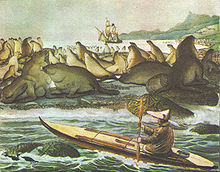
The end of the 19th century was marked by the Bering Sea Controversy between the United States and Great Britain over the management of fur seal harvests.[9] In 1867 the United States government purchased from Russia all her territorial rights in Alaska and the adjacent islands, including the Pribilof Islands, the principal breeding-grounds of the seals in those waters. By Acts of Congress, the killing of seals was strictly regulated on the Pribiloff islands and in "the waters adjacent thereto". Beginning in about 1886, it became the practice of certain British and Canadian vessels to intercept passing seals in the open ocean (over three miles from any shore) and shoot them in the water (pelagic sealing).[46] In the summer of 1886, three British Columbian sealers, the Carolena, the Onward, and Thornton, were captured by an American revenue cutter, the Corwin.[47] The United States claimed exclusive jurisdiction over the sealing industry in the Bering Sea; it also contended that the protection of the fur seal was an international duty, and should be secured by international arrangement. The British imperial government repudiated the claim, but was willing to negotiate on the question of international regulation.

The issue was taken to arbitration, which concluded in favour of Britain on all points in 1893. Since the decision was in favor of Great Britain, in accordance with the arbitration treaty the tribunal prescribed a series of regulations for preserving the seal herds which were to be binding upon and enforced by both powers. They limited pelagic sealing as to time, place, and manner by fixing a zone of 60 miles (97 km) around the Pribilof Islands within which the seals were not to be molested at any time, and from 1 May to 31 July each year they were not to be pursued anywhere in the Bering Sea. Only licensed sailing vessels were permitted to engage in fur sealing, and the use of firearms or explosives was prohibited.
This marked the first attempt at establishing regulations on the sealing industry for environmental purposes.[46] However, these regulations failed because the mother seals fed outside the protected area and remained vulnerable.[9] A joint commission of scientists from Britain and the United States further considered the problem, and came to the conclusion that pelagic sealing needed to be curtailed. However, further joint tribunals did not enact new legal restrictions and, at this point, Japan also embarked upon pelagic sealing.[9]
Finally, the North Pacific Fur Seal Convention severely curtailed the sealing industry. Signed on 7 July 1911, by the United States, Great Britain, Japan and Russia, the treaty was designed to manage the commercial harvest of fur-bearing mammals. It outlawed open-water seal hunting and acknowledged the United States' jurisdiction in managing the on-shore hunting of seals for commercial purposes. It was the first international treaty to address wildlife preservation issues.[48]
The treaty was dissolved with the onset of hostilities between the signatories in World War II. However, the treaty set precedent for future national and international laws and treaties, including the Fur Seal Act of 1966 and the Marine Mammal Protection Act of 1972.[48]
Today, commercial sealing is conducted by only five nations: Canada, Greenland, Namibia, Norway, and Russia. The United States, which had been heavily involved in the sealing industry,[citation needed] now maintains a complete ban on the commercial hunting of marine mammals, with the exception of indigenous peoples who are allowed to hunt a small number of seals each year.[49][50]
Equipment and methods
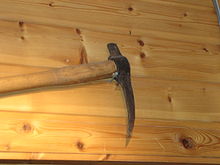
In the Canadian commercial seal hunt, the majority of the hunters initiate the kill using a firearm. Ninety percent of sealers on the ice floes of the Front (east of Newfoundland), where the majority of non-native seal hunting occurs, use firearms.[51]
An older and more traditional method of killing seals is with a hakapik: a heavy wooden club with a hammer head and metal hook on the end. The hakapik is used because of its efficiency; the animal can be killed quickly without damage to its pelt. The hammer head is used to crush the seals' thin skulls, while the hook is used to move the carcasses. Canadian sealing regulations describe the dimensions of the clubs and the hakapiks, and caliber of the rifles and minimum bullet velocity, that can be used. They state: "Every person who strikes a seal with a club or hakapik shall strike the seal on the forehead until its skull has been crushed", and that "No person shall commence to skin or bleed a seal until the seal is dead", which occurs when it "has a glassy-eyed, staring appearance and exhibits no blinking reflex when its eye is touched while it is in a relaxed condition."[52] Reportedly, in one study, three out of eight times, the animal was not rendered either dead or unconscious by shooting, and the hunters would then kill the seal using a hakapik or other club of a type that is sanctioned by the governing authority.[53]
Modern sealing
Products made from seals
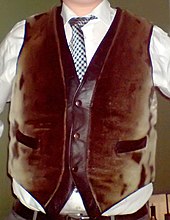

Seal skins have been used by aboriginal people for millennia to make waterproof jackets and boots, and seal fur to make fur coats. Pelts account for over half the processed value of a seal, selling at over C$100 each as of 2006.[54] According to Paul Christian Rieber, of GC Rieber AS, the difficult ice conditions and low quotas in 2006 resulted in reduced access to seal pelts, which caused the commodity price to be pushed up.[55] One high-end fashion designer, Donatella Versace, has begun to use seal pelts, while others, such as Calvin Klein, Stella McCartney, Tommy Hilfiger, and Ralph Lauren, refrain from using any kind of fur.[56][57]
Seal meat is a source of food for residents of small coastal communities.[58] Meat is sold in the Asian pet food market; in 2004, only Taiwan and South Korea purchased seal meat from Canada.[59] Seal blubber is used to make seal oil, marketed as a fish oil supplement. In 2001, 2% of Canada's raw seal oil was processed and sold in Canadian health stores.[60] There has been virtually no market for seal organs since 1998.[58]
Sealing states
In 2005, three companies exported seal skin: Rieber in Norway, Atlantic Marine in Canada and Great Greenland in Greenland.[61] Their clients were earlier French fashion houses and fur makers in Europe, but today the fur is mainly exported to Russia and China.[61]
Canada
In Canada, the season for the commercial hunt of harp seal is from 15 November to 15 May.[62] While Inuit hunt seals commercially year-round, most sealing in southern Canada occurs in late March in the Gulf of St. Lawrence, and during the first or second week of April off Newfoundland, in an area known as the Front. This peak spring period is often mistakenly referred to as the "Canadian Seal Hunt", when in fact seal hunting also happens throughout the year all over the Canadian Arctic.[1]
In 2003, the three-year harp seal quota granted by Fisheries and Oceans Canada was increased to a maximum of 975,000 animals per three years, with a maximum of 350,000 animals in any two consecutive years.[62] As of 2012, the population in Canada of the Northwest Atlantic harp seals is approximately 7.3 million animals, over three times what it was in the 1970s.[63]
Although around 70% of Canadian seals killed are taken on the Front,[1] private monitors focus on the St. Lawrence hunt, because of its more convenient location.[64] The 2006 St. Lawrence leg of the hunt was officially closed on 3 April 2006; sealers had already exceeded the quota by 1,000 animals.[65] On 26 March 2007, the Newfoundland and Labrador government launched a seal hunt website to counter "misinformation about the sealing industry that is by international animal rights organizations".[66]
Warm winters in the Gulf of Saint Lawrence have led to thinner and more unstable ice there. In 2007, Canada's federal fisheries ministry reported that while the pups are born on the ice as usual, the ice floes have started to break up before the pups learn to swim, causing the pups to drown.[67] Canada reduced the 2007 quota by 20%, because overflights showed large numbers of seal pups were lost to thin and melting ice.[68] In southern Labrador and off Newfoundland's northeast coast, however, there was extra heavy ice in 2007, and the coast guard estimated as many as 100 vessels were trapped in ice simultaneously.[69][70]
The 2010 hunt was cut short because demand for seal pelts was down. Only one local pelt buyer, NuTan Furs, offered to purchase pelts; and it committed to purchase less than 15,000 pelts.[71] Pelt prices were about C$21/pelt in 2010, which is about twice the 2009 price and about 64% of the 2007 price. The reduced demand is attributable mainly to the 2009 ban on imports of seal products into the European Union.
The 2010 winter was unusually warm, with little ice forming in the Gulf of St. Lawrence in February and March, when harp seals give birth to their pups on ice floes. Around the Gulf, harp seals arrived in late winter to give birth on near-shore ice and even on beaches rather than on their usual whelping grounds: sturdy sea ice. Also, seal pups born elsewhere began floating to shore on small, shrinking pieces of ice. Many others stayed too far north, out of reach of all but the most determined hunters. Environment Canada, the weather forecasting agency, reported the ice was at the lowest level on record.[72]
Regulations
The Fisheries Act established "Seal Protection Regulations" in the mid-1960s. The regulations were combined with other Canadian marine mammals regulations in 1993, to form the "Marine Mammal Regulations".[73][74][75] In addition to describing the use of the rifle and hakapik, the regulations state every person "who fishes for seals for personal or commercial use shall land the pelt or the carcass of the seal."[64] The commercial hunting of infant harp seals (whitecoats) and infant hooded seals (bluebacks) was banned in 1987 under pressure from animal rights groups. Now, seals may only be killed once they have started molting (from 12 to 15 days of age), as this coincides with the time when they are abandoned by their mothers.
Export
Canada's biggest market for seal pelts is Norway.[76] Carino Limited is one of Newfoundland's largest seal pelt producers. Carino (CAnada–RIeber–NOrway) is marketing its seal pelts mainly through its parent company, GC Rieber Skinn, Bergen, Norway.[77] Canada sold pelts to eleven countries in 2004. The next largest were Germany, Greenland, and China/Hong Kong. Other importers were Finland, Denmark, France, Greece, South Korea, and Russia.[59] Asia remains the principal market for seal meat exports.[62] One of Canada's market access priorities for 2002 was to "continue to press Korean authorities to obtain the necessary approvals for the sale of seal meat for human consumption in Korea."[78] Canadian and Korean officials agreed in 2003 on specific Korean import requirements for seal meat.[78] For 2004, only Taiwan and South Korea purchased seal meat from Canada.[59]
Canadian seal product exports reached C$18 million in 2006. Of this, C$5.4 million went to the EU.[79] In 2009, the European Union banned all seal imports, shrinking the market.[80] Where pelts once sold for more than $100, they now fetch $8 to $15 each.[72]
Greenland
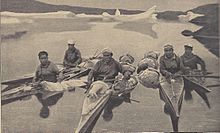

Seals are abundant in Greenland with an estimated total population of 12 million, and about 82,000 harp seals, 78,000 ringed seals and a much lower number of hooded seals are killed each year (historically, a couple of other seal species were also hunted).[81] The hunter has to have a hunting license and he/she is obliged to register all kills with the authorities. Young seals and mothers with young are fully protected.[4]
Hunting is done with a rifle or shotgun, which by law has to be at least a .22 caliber or a 20-gauge, respectively.[4] The most common and widespread method involves using a small boat to slowly approach a seal sitting on ice or swimming at the surface of the water, and shoot it from a distance, aiming for the head. Once shot and killed, the boat rushes up to the seal and hooks the carcass out of the water before it sinks.[81][82] Another method is sometimes used in places where the sea is almost entirely covered by ice. The hunter slowly crawls forwards on the ice towards a seal, hiding behind a white screen. Once within shooting range, the seal is shot.[81] Although the killed seal can be retrieved with the use of a snowmobile, it is illegal to use a motor vehicle (including snowmobile), plane or helicopter in the hunt itself.[4]
Seal hunting is very important to the local societies, especially small rural villages. In 2011, there were almost 8,000 hunters, including 2,100 full-time (the remaining are often fishers–hunters), out of a total work force of 32,000 people in Greenland.[81] The meat is usually consumed locally and the skin is also used for local clothes (for example, Greenland's National Costume contains seal skin, including in the kamiks) or sold abroad.[83] However, exports were hard hit by international campaigns against seal pelts, starting in 1980s (to some degree also later) and often focussing on seals being killed by clubbing or similar methods (especially young, but also adults), methods that were and are not in use in Greenland.[5] As a consequence, Greenland attempted to distance itself from places where such methods were in use. For example, Greenland banned imports of seal skin from Canada for a period in 2006, specifically citing the way seals were killed.[5] The European Union ban on seal skins has an exemption for those that originate from subsistence hunts by Inuit or other indigenous communities and using methods where animal welfare is considered (i.e., killed using humane methods),[84] which has allowed Greenland to continue the trade.[4] Nevertheless, the number of skins treated for commercial sale (both local and international) has fallen considerably in recent years and by 2017 was below 25,000.[85]
Namibia
| Year | Annual Quota | Catch |
| Before 1990 | 17,000 pups[86] | |
| 1998–2000 | 30,000 pups[87] | |
| 2001–2003 | 60,000 pups[87] | |
| 2004–2006 | 60,000 pups, 7,000 bulls[87] | |
| 2007 | 80,000 pups, 6,000 bulls[88] | |
| 2008 | 80,000 pups, 6,000 bulls[88] | 23,000 seals[89] |
| 2009 | 85,000 pups, 7,000 bulls[90] | |
| 2010 | 85,000 pups, 7,000 bulls[90] |
Namibia is the only country in the Southern Hemisphere culling seals. Although the protection and the sustainable use of natural resources is part of Namibia's constitution, it claims to conduct the second largest seal hunt in the world,[87] mainly because of the huge amount of fish seals are estimated to consume. While a government-initiated study found seal colonies consume more fish than the entire fishing industry can catch,[88] animal protection society Seal Alert South Africa estimated less than 0.3% losses to commercial fisheries.[86]
Hunting is done from July to November[86] on two places, Cape Cross and Atlas Bay, and in the past at Wolf Bay.[88] These two colonies together account for 75% of the Cape fur seal population of the country.[87]
Cape Cross is a tourism resort and the largest Cape fur seal colony in Namibia. The Department of Tourism has stated[91] that "Cape Cross Seal Reserve was established to protect the largest breeding colony of Cape fur seals in the world". In season, the resort is closed and sealed off during the culling in the early morning hours, journalists are not allowed to enter.[89] Namibia's SPCA is allowed to observe the culling from 2010 onwards.[90]
Namibia's Ministry of Fisheries announced a three-year rolling quota for the seal harvest, although different quotas per year are sometimes reported.[88][89] The latest[update] quota announced was in 2009, valid until 2011.[90] The quotas are usually not filled by the concession holders.[86]
In 2009, an unusual bid to end seal culling in Namibia was attempted when Seal Alert tried to raise money to purchase the only buyer of Namibian seals, Australian-based Hatem Yavuz, in its entirety for US$14.2 million.[89] The project did not materialise. Also, the Government of Namibia offered the International Fund for Animal Welfare (IFAW) an opportunity to buy out the two sealers in Namibia to finally end the culling. The offer was rejected.[87]
In 2011, South African activists launched a boycott of Namibian tourism and Namibian products[92][self-published source?] in response to the cull.
Norway
| Year | Quota | Catch |
| 1950 | 255,056[93] | |
| 1955 | 295,172[93] | |
| 1960 | 216,034[93] | |
| 1965 | 140,118[93] | |
| 1970 | 188,980[93] | |
| 1975 | 112,274[93] | |
| 1980 | 60,746[93] | |
| 1985 | 19,902[93] | |
| 1990 | 15,232[93] | |
| 1992 | 14,076[94] | |
| 1993 | 12,772 | |
| 1994 | 18,113 | |
| 1995 | 15,981 | |
| 1996 | 16,737 | |
| 1997 | 10,114 | |
| 1998 | 9,067 | |
| 1999 | 6,399 | |
| 2000 | 20,549 | |
| 2001 | ||
| 2002 | 10,691[95] | |
| 2003 | 12,870[93] | |
| 2004 | 30,600[96] | 14,746[93] |
| 2005 | 30,600[97] | 21,597[93] |
| 2006 | 45,200[98] | 17,037[93] |
| 2007 | 46,200[99] | 8,000[100] |
| 2008 | 31,000[100] | 1,260[101] |
| 2011 | 49,400[102] | 7,673[102] |
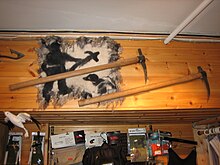


The Norwegian sealing season runs from January to September. The hunt involves "seal catching" by seagoing sealing boats on the Arctic ice shelf, and "seal hunting" on the coast and islands of mainland Norway. The latter is carried out by small groups of licensed hunters shooting seals from land and using small boats to retrieve the catch.
In 2005, Norway allowed foreign nationals to take part in the hunt.[103] In 2006, 17,037 seals (including 13,390 harp and 3,647 hooded seals) were killed.[93] In 2007, the Norwegian Ministry of Fisheries and Coastal Affairs stated up to 13.5 million Norwegian krone (about US$2.6 million) would be given in funding to vessels in the 2007 Norwegian seal hunt.[104]
Regulations
Zdroj:https://en.wikipedia.org?pojem=Seal_huntingText je dostupný za podmienok Creative Commons Attribution/Share-Alike License 3.0 Unported; prípadne za ďalších podmienok. Podrobnejšie informácie nájdete na stránke Podmienky použitia.
Antropológia
Aplikované vedy
Bibliometria
Dejiny vedy
Encyklopédie
Filozofia vedy
Forenzné vedy
Humanitné vedy
Knižničná veda
Kryogenika
Kryptológia
Kulturológia
Literárna veda
Medzidisciplinárne oblasti
Metódy kvantitatívnej analýzy
Metavedy
Metodika
Text je dostupný za podmienok Creative
Commons Attribution/Share-Alike License 3.0 Unported; prípadne za ďalších
podmienok.
Podrobnejšie informácie nájdete na stránke Podmienky
použitia.
www.astronomia.sk | www.biologia.sk | www.botanika.sk | www.dejiny.sk | www.economy.sk | www.elektrotechnika.sk | www.estetika.sk | www.farmakologia.sk | www.filozofia.sk | Fyzika | www.futurologia.sk | www.genetika.sk | www.chemia.sk | www.lingvistika.sk | www.politologia.sk | www.psychologia.sk | www.sexuologia.sk | www.sociologia.sk | www.veda.sk I www.zoologia.sk
